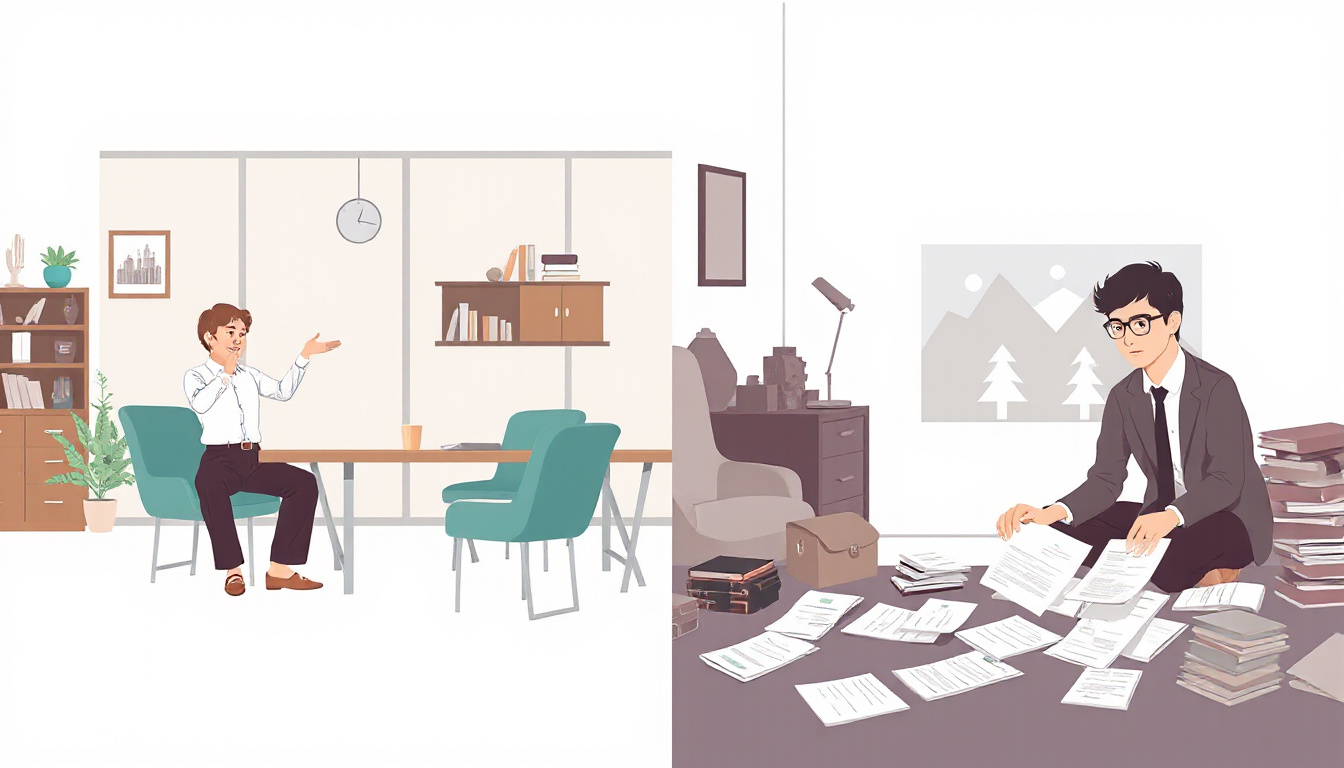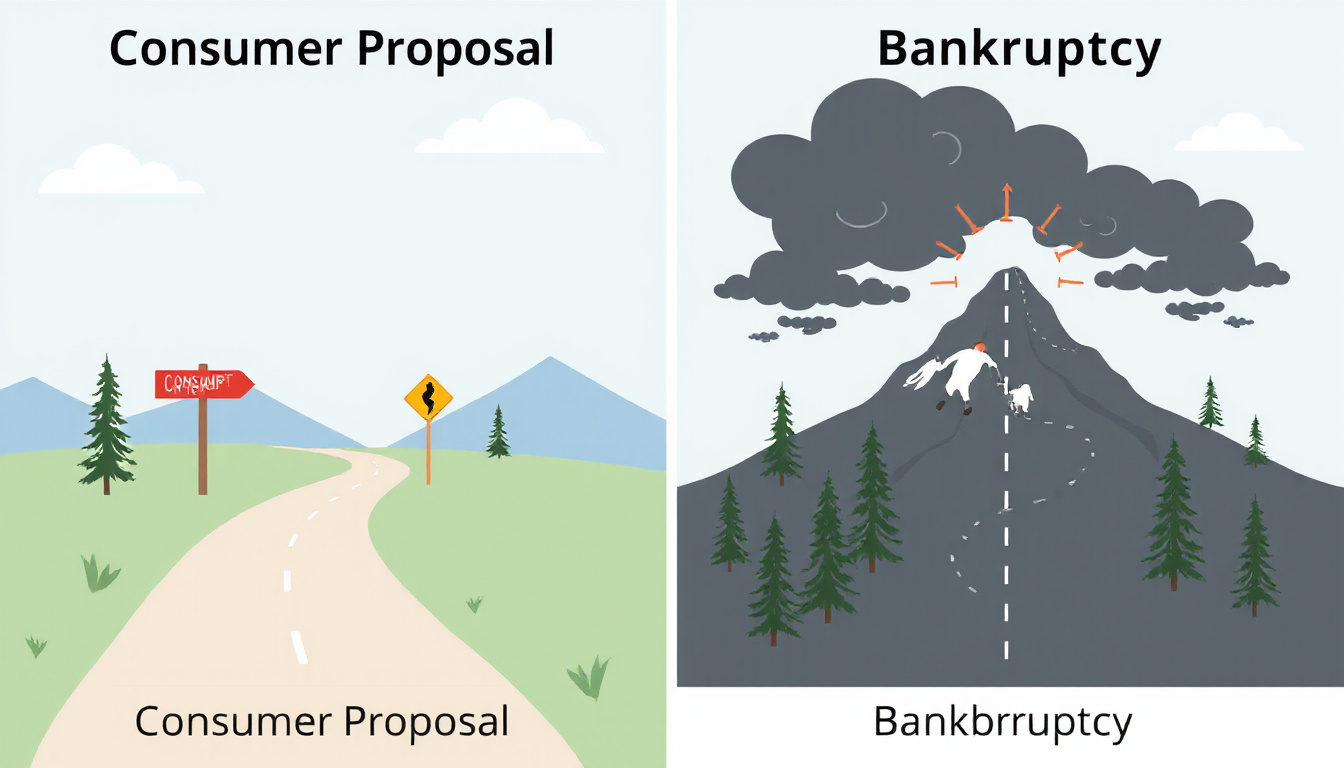Consumer Proposal vs Bankruptcy: A 2025 Comparison

Tyler McAllister
Senior Finance Writer
When faced with overwhelming debt, deciding between a consumer proposal and bankruptcy is a crucial choice that can shape your financial future. This post aims to clarify these two options and help you determine the best path for your circumstances. Whether you’re a Canadian consumer trying to find relief or a business owner looking to manage debt obligations, understanding the nuances of these processes is vital. We will explore what each option entails, their benefits and drawbacks, and how to make an informed decision tailored to your financial situation in
2025.

Key Takeaways
- Consumer proposals offer a structured repayment plan to avoid bankruptcy.
- Bankruptcy provides a fresh start but can have long-lasting financial repercussions.
- Key differences include the impact on credit scores and asset retention.
- Choosing the right option depends on individual financial circumstances and goals.
- Seeking professional advice can clarify the best path between a consumer proposal and bankruptcy.
Understanding Consumer Proposals
## Understanding Consumer Proposals
In Canada, both consumer proposals and bankruptcy are legal options for individuals struggling with overwhelming debt. Understanding the differences between the two can help you make an informed decision about which path to take. A consumer proposal is a formal agreement to pay back a portion of your debt over a fixed period, typically at a lower amount than what you owe. You propose this repayment plan to your creditors, and if they accept it, you can avoid bankruptcy while still discharging a part of your obligations. On the other hand, bankruptcy is a legal process that releases you from most of your debts, but it comes at a greater cost to your credit rating and can require you to surrender some assets.
The choice between a consumer proposal and bankruptcy often hinges on your specific financial situation, your ability to repay some debt, and how much you want to preserve your assets and credit rating.
Bankruptcy Basics and Process
# Consumer Proposal vs Bankruptcy: A 2025 Comparison
## Bankruptcy Basics and Process
When faced with overwhelming debt and limited financial prospects, Canadians often grapple with whether to file for bankruptcy or propose a consumer proposal. Understanding the basics of each option can clarify your choices.
### What is Bankruptcy?
Bankruptcy is a legal process designed to relieve you of most of your debts when you cannot keep up with payments. It allows individuals to start fresh financially. Upon filing for bankruptcy, an official receiver manages your assets, and most of your unsecured debts are discharged within approximately nine months. However, not all debts are eliminated; for example, student loans, child support, and certain taxes may still require payment.
### The Bankruptcy Process
1. Consult with a Licensed Insolvency Trustee (LIT): The first step is to meet with an LIT who will discuss your financial situation and help you understand your options.
2. Filing for Bankruptcy: If bankruptcy is appropriate, your LIT will assist you in filing the necessary paperwork and represent you in dealings with creditors.
3. Asset Evaluation: The LIT reviews your assets to determine what can be retained, as some assets may be liquidated to repay creditors.
4. Mandatory Counseling Sessions: You’ll participate in financial counselling sessions designed to equip you with the necessary skills to manage your finances post-bankruptcy.
5. Asset Liquidation and Debt Discharge: After the process, the court will issue a discharge from your debts, barring any exclusions.
### Impact on Your Credit Rating
Filing for bankruptcy can severely impact your credit rating. Initially, it will be marked as a ‘R9’ rating on your credit report, the most negative classification, and will remain for six to seven years, depending on the province and if it’s your first bankruptcy.
A bankruptcy can offer a fresh start, but it requires careful consideration. You’ll need to weigh the emotional and financial implications it carries, including potential losses of property.
‘The first step towards getting somewhere is to decide you’re not going to stay where you are.’ – J.P. Morgan

Key Differences Between Consumer Proposals and Bankruptcy
In Canada, navigating financial distress often leads individuals to consider two primary options: consumer proposals and bankruptcy. Understanding the differences between consumer proposals and bankruptcy is crucial for anyone facing substantial debt. A consumer proposal allows you to repay a portion of your debts over a set period, typically five years, while avoiding the harsher repercussions of bankruptcy. Bankruptcy, on the other hand, involves discharging most of your debts but comes with more severe legal and financial consequences. A key difference lies in your assets; with a consumer proposal, you can often keep your property, whereas, in bankruptcy, some assets may be liquidated to pay creditors. The impact on your credit rating also varies: a consumer proposal generally results in a less significant decline than bankruptcy, which can stay on your record for up to seven years. Moreover, both processes require you to work alongside a licensed insolvency trustee, but the degree of financial counselling and management differs significantly between the two options. Therefore, it’s essential to carefully weigh your circumstances, options, and long-term goals when deciding between a consumer proposal and bankruptcy.
Choosing the Right Option for Your Financial Situation
When faced with overwhelming debt, it’s crucial to explore all potential solutions that best suit your financial situation. Two common options for Canadians are consumer proposals and bankruptcy. Each has different implications on your credit rating, repayment terms, and even your personal assets. To determine the best route for your recovery, consider factors such as the total amount of debt you owe, your income level, and your ability to make repayments. Consult with a licensed insolvency trustee to gain insights into how consumer proposals might allow you to negotiate your debts while avoiding bankruptcy, which can lead to more severe long-term financial repercussions. Choosing wisely can set the foundation for a successful financial recovery.
Frequently Asked Questions
What is a consumer proposal?
A consumer proposal is a formal agreement between a debtor and creditors to settle debts for less than the total amount owed, allowing the debtor to repay in manageable installments over a specific period.
How does bankruptcy work?
Bankruptcy is a legal process that helps individuals eliminate or reduce debts under the protection of the bankruptcy court, allowing for the discharge of most unsecured debts after a specified period.
What are the key differences between a consumer proposal and bankruptcy?
The main differences include the impact on credit scores, the length of the process, the amount of debt that can be included, and potential asset retention; consumer proposals generally have less severe repercussions than full bankruptcy.
How do I decide between a consumer proposal and bankruptcy?
The choice depends on your personal financial situation, including the amount of debt, assets you wish to retain, income, and your capacity to make payments. Consulting a financial advisor can aid in making the best decision.
What are the long-term effects of choosing a consumer proposal versus bankruptcy?
A consumer proposal typically results in a less severe impact on your credit rating and allows you to keep certain assets, while bankruptcy can lead to a more significant long-term damage to credit scores and loss of assets.
